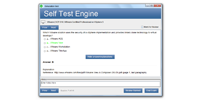ダウンロード可能なインタラクティブSalesforce-MuleSoft-Developer-Iテストエンジン
Salesforce MuleSoftの基礎準備資料問題集には、Salesforce MuleSoft Salesforce-MuleSoft-Developer-I試験を受けるために必要なすべての材料が含まれています。詳細は、正確で論理的なものを作成するために業界の経験を常に使用しているSalesforce MuleSoft によって研究と構成されています。
Salesforce-MuleSoft-Developer-I試験の品質と価値
JPNTestのSalesforce MuleSoft Salesforce-MuleSoft-Developer-I模擬試験問題集は、認定された対象分野の専門家と公開された作成者のみを使用して、最高の技術精度標準に沿って作成されています。
あなたのSalesforce-MuleSoft-Developer-I試験合格を100%保証
JPNTestテスト問題集を初めて使用したときにSalesforce MuleSoft Salesforce-MuleSoft-Developer-I試験(Salesforce Certified MuleSoft Developer I)に合格されなかった場合は、購入料金を全額ご返金いたします。
JPNTestでSalesforce Salesforce-MuleSoft-Developer-I問題集をチョイスする理由
JPNTestは、1週間で完璧に認定試験を準備することができる、忙しい受験者に最適な問題集を提供しております。 Salesforce-MuleSoft-Developer-Iの問題集は、Salesforceの専門家チームがベンダーの推奨する授業要綱を深く分析して作成されました。弊社のSalesforce-MuleSoft-Developer-I学習材料を一回のみ使用するだけで、Salesforce認証試験に合格することができます。
Salesforce-MuleSoft-Developer-IはSalesforceの重要な認証であり、あなたの専門スキルを試す認定でもあります。受験者は、試験を通じて自分の能力を証明したいと考えています。 JPNTest Salesforce Certified MuleSoft Developer I は、Salesforce MuleSoftの237の問題と回答を収集して作成しました。Salesforce Certified MuleSoft Developer Iの知識ポイントをカバーし、候補者の能力を強化するように設計されています。 JPNTest Salesforce-MuleSoft-Developer-I受験問題集を使用すると、Salesforce Certified MuleSoft Developer Iに簡単に合格し、Salesforce認定を取得して、Salesforceとしてのキャリアをさらに歩むことができます。
デモをダウンロードする
Salesforce-MuleSoft-Developer-Iの迅速なアップデート対応
Salesforce-MuleSoft-Developer-I試験に変更がございました場合は、現在の試験と一致するよう、瞬時に学習資料を更新することができます。弊社は、お客様に最高、最新のSalesforce Salesforce-MuleSoft-Developer-I問題集を提供することに専念しています。なお、ご購入いただいた製品は365日間無料でアップデートされます。
Salesforce Salesforce-MuleSoft-Developer-I 認定試験の出題範囲:
| トピック | 出題範囲 |
|---|
| トピック 1 | - Creating Application Networks: The topic of creating Application Networks encompasses understanding MuleSoft’s proposal for closing the IT delivery gap and describing the role and characteristics of the modern API. It also includes the purpose and roles of a Center for Enablement (C4E), and the benefits of API-led.
|
| トピック 2 | - Deploying and Managing APIs and Integrations: It includes packaging Mule applications for deployment and deploying them to CloudHub. This topic also involves using CloudHub properties, creating and deploying API proxies, connecting an API implementation to API Manager, and applying policies to secure an API.
|
| トピック 3 | - Transforming Data with DataWeave: It involves writing DataWeave scripts and using DataWeave functions. This topic also includes defining and using DataWeave variables, functions, and modules, and applying correct syntax.
|
| トピック 4 | - Handling Errors: Handling errors includes describing default error handling in Mule applications and defining custom global default error handlers. It involves comparing On Error Continue and On Error Propagate scopes, creating error handlers for a flow, using the Try scope, and mapping errors to custom application errors.
|
| トピック 5 | - Using Connectors: It focuses on retrieving data from REST services using HTTP Request or REST Connector. Moreover, the topic covers using a Web Service Consumer connector for SOAP web services and the Transform Message component.
|
| トピック 6 | - Structuring Mule Applications: Structuring Mule applications covers parameterizing an application and defining and reusing global configurations. It includes breaking an application into multiple flows using private flows, subflows, and the Flow Reference component.
|
| トピック 7 | - Debugging and Troubleshooting Mule Applications: Using breakpoints to inspect a Mule event during runtime, installing missing Maven dependencies, and reading and deciphering Mule log error messages are sub-topics of this topic.
|
| トピック 8 | - Designing APIs: Designing APIs involves describing the lifecycle of the modern API and using RAML to define various aspects of an API. It includes identifying when to use query parameters vs URI parameters, and defining API parameters.
|
参照:https://trailhead.salesforce.com/help?article=Salesforce-Certified-MuleSoft-Developer-I-Exam-Guide


 357 お客様のコメント
357 お客様のコメント





